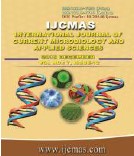


 National Academy of Agricultural Sciences (NAAS)
National Academy of Agricultural Sciences (NAAS)

|
PRINT ISSN : 2319-7692
Online ISSN : 2319-7706 Issues : 12 per year Publisher : Excellent Publishers Email : editorijcmas@gmail.com / submit@ijcmas.com Editor-in-chief: Dr.M.Prakash Index Copernicus ICV 2018: 95.39 NAAS RATING 2020: 5.38 |
ESBL producing clinical isolates of gram negative organisms are major burden in hospital as well as in the community. These organisms are the causative agent for septicemia. Carbapenem group (Imipenem and Ertapenem) are the drug of choice for treating such infections. Recently increased incidences of resistance to Imipenem were reported, that makes the management of sepsis difficult. Aim of the study was to evaluate the susceptibility pattern of ertapenem in ESBL producing gram negative bacilli isolated from patients with septicemia in a teaching medical college covering predominantly rural population. Hospital based prospective study was conducted at SRM Medical College Hospital and Research Centre, Potheri, Kancheepuram, from septicemia diagnosed cases. The blood samples were collected and processed by standard methods. Isolation and identification of organisms was done as per standard guidelines. Antimicrobial sensitivity was determined by Kirby Bauer’s Disc diffusion method as per CLSI guidelines. Evaluation of susceptible pattern of ertapenem from imipenem resistant ESBL producing gram negative isolates was studied. Among 765, 416 (54.37%) were male and 349 (45.62 %) were female. Of 765, 114 (14.9 %) showed positive. Out of 114, 52.66 % (60/114) were gram positive organisms, 44.73 % (51/114) were gram negative organisms and 2.63 % (3/114) were fungal isolates. Among 51 gram negative isolates, 16 (31.37 %) isolates were ESBL producers. Out of 16 ESBL isolates, 7(43.75%) were Imipenem resistant. Out of 7 Imipenem resistant, 5 (71.42%) were ertapenem sensitive and 2(28.57%) were ertapenem resistant. Present study showed low-level ertapenem resistance in imipenem resistance ESBL producing gram negative isolates. Ertapenem may be a viable alternative to other carbapenems for the treatment of infections caused by ESBL producing clinical isolates. Clinical outcome studies are required to determine if ertapenem is effective for the treatment of infections caused by these organisms.
 |
 |
 |
 |
 |